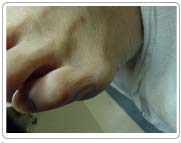What is it?
You have developed a bunion. This causes two problems. Your big toe is bending towards your second toe. Also the bump on the joint of your big toe sticks out. It usually makes finding comfortable shoes difficult. The bump on your toe may be red and sore. The aim of the operation is to reduce the pain that you get from your bunion.
The Operation
 You will have a general anaesthetic, and will be asleep for the whole operation. Your toe will be straightened. This is done by breaking the bone and moving your toe into a new position. This is called an osteotomy. A cut is made over the top of your abnormal joint. The bony lump on the side of the joint is then removed. A bone in your foot is cut and your toe moved into a better position. The bones may, or may not, be held with a screw or special staple until they heal together. The skin wound is then closed up with stitches. A plaster cast is put on your foot to hold your big toe in its new position.
You will have a general anaesthetic, and will be asleep for the whole operation. Your toe will be straightened. This is done by breaking the bone and moving your toe into a new position. This is called an osteotomy. A cut is made over the top of your abnormal joint. The bony lump on the side of the joint is then removed. A bone in your foot is cut and your toe moved into a better position. The bones may, or may not, be held with a screw or special staple until they heal together. The skin wound is then closed up with stitches. A plaster cast is put on your foot to hold your big toe in its new position.
You will be in hospital either just for the day of the operation or for one more day. . You will be in a plaster for approximately six weeks.
Any Alternatives
Most people try pads from the chemists or the chiropodists before seeing an orthopaedic surgeon. If the pads have not helped, and your toe is painful, probably the best plan is to straighten your toe. You should not have the operation just to make your feet look better.
Before the operation
Stop smoking and get your weight down if you are overweight. (See Healthy Living). If you know that you have problems with your blood pressure, your heart, or your lungs, ask your family doctor to check that these are under control. Check the hospital's advice about taking the Pill or hormone replacement therapy (HRT). Check you have a relative or friend who can come with you to the hospital, take you home, and look after you for the first week after the operation. Bring all your tablets and medicines with you to the hospital. On the ward, you may be checked for past illnesses and may have special tests to make sure that you are well prepared and that you can have the operation as safely as possible. Many hospitals now run special preadmission clinics, where you visit for an hour or two, a few weeks or so before the operation for these checks.
After - In Hospital
Your will have a plaster cast on your foot. Your foot may be painful. You will be given injections or tablets to control this. Ask for more if the pain is getting worse. A general anaesthetic will make you slow, clumsy and forgetful for about 24 hours. The nurses will help you with everything you need until you are able to do things for yourself. Do not make important decisions during this time. Your plaster cast will be changed and your stitches taken out three weeks or so after your operation. You must not get your plaster cast wet. You will be given an appointment to visit the orthopaedic outpatient department three weeks or so after your operation. The nurses will advise about sick notes, certificates etc.
After - At Home
When you go home, you must rest with your foot up but, you will be able to move around the house and manage stairs. You will not be able to go shopping for the first few weeks after you go home. Please make arrangements for friends or family to shop for you. Your toe will continue to improve for at least six months. Looking after a plaster cast:
- Do not press on the plaster for 48 hours.
- Do not let the plaster cast get wet.
- Do not cut or bang the plaster.
Do not put anything down the inside of the plaster (eg coins). Do not use anything to scratch under the plaster.
Come back to the hospital if:
- you have pins and needles or numbness in your toes
- you cannot move your toes
- your toes go blue
- your toes become very swollen
- you have severe pain.
If you experience such problems it means that there is problem with the nerves and/or the blood vessels of your foot or that there is an infection and you need to come back to the hospital urgently.
Come back to see the plaster technician:
- if the plaster cracks
- the plaster becomes soft
- the plaster is getting loose.
You must not drive until your toe is completely comfortable. You are unlikely to drive for at least eight weeks after your operation. How soon you can return to work depends on your job. If you can get to work without driving yourself or by using public transport you may be able to return to work six weeks after your operation.
Possible Complications
As with any operation under general anaesthetic there is a very small risk of complications related to your heart or your lungs. The tests that you will have before the operation will make sure that you can have the operation in the safest possible way and will bring the risk for such complications very close to zero.
Rarely, you can develop an infection in the area of the operation which can be settled by taking antibiotics for a few days.
Also rarely, a nerve or a blood vessel can be damaged during the operation and you might need another operation to fix the problem.
The bones may not join together firmly. If this occurs, a further operation may be necessary.
Advanced Reproductive Technology
- In Vitro Fertilisation (IVF)
- Intracytoplasmic Sperm Injection (ICSI)
- Donor egg and embryo programs
- In Vitro Fertilisation (IVF)
- Pre-implantation genetic diagnosis (PGD)
- Surrogacy programs
Dental Videos





